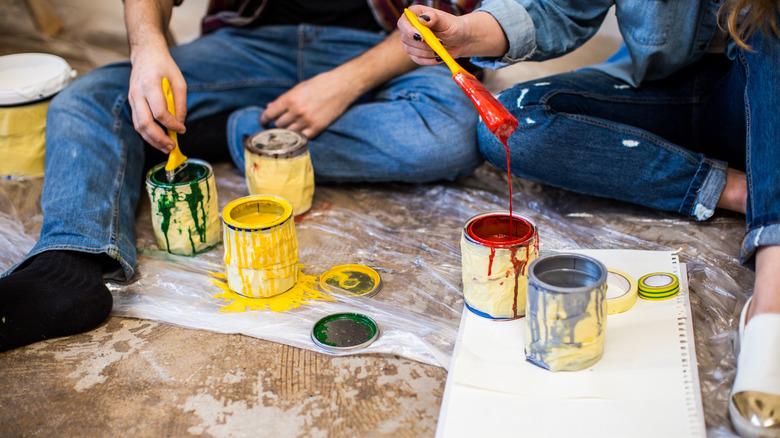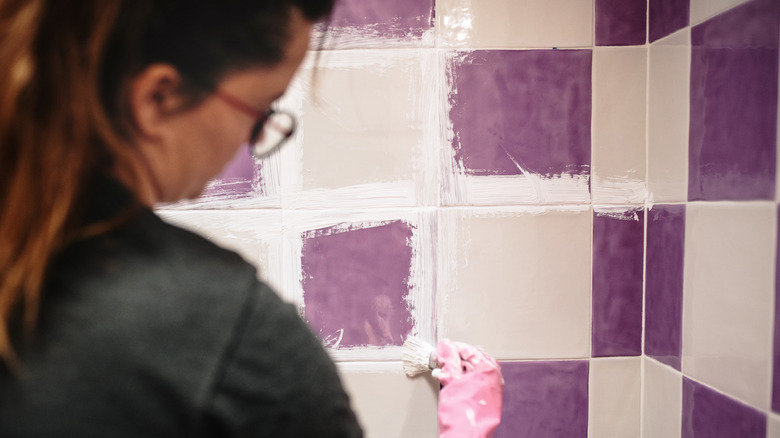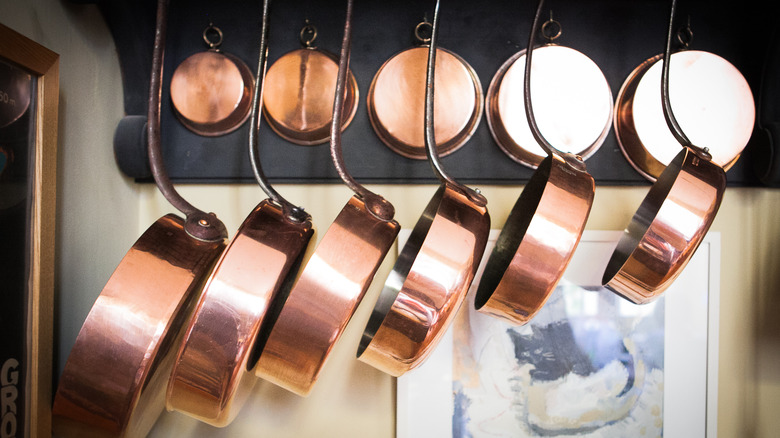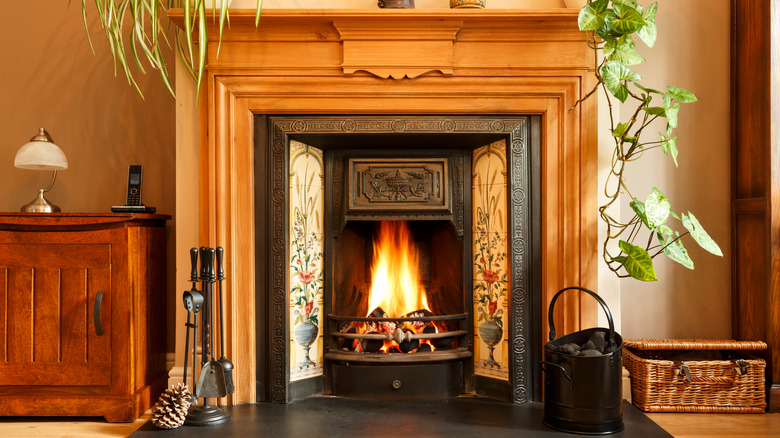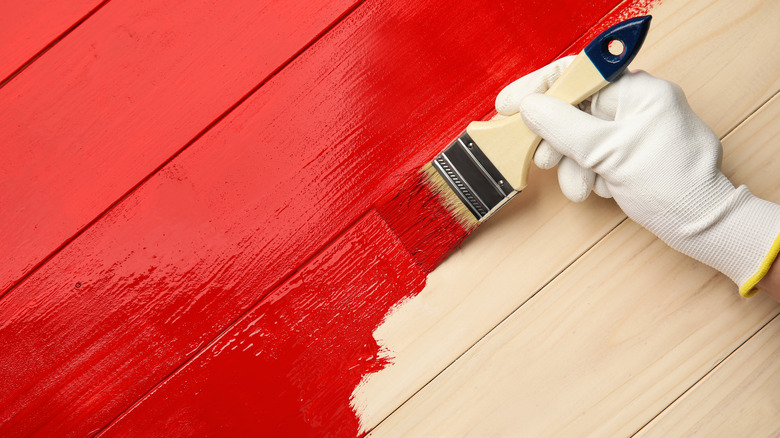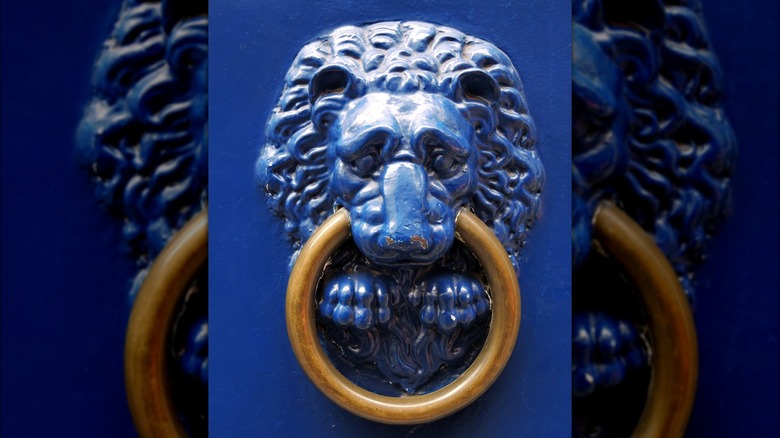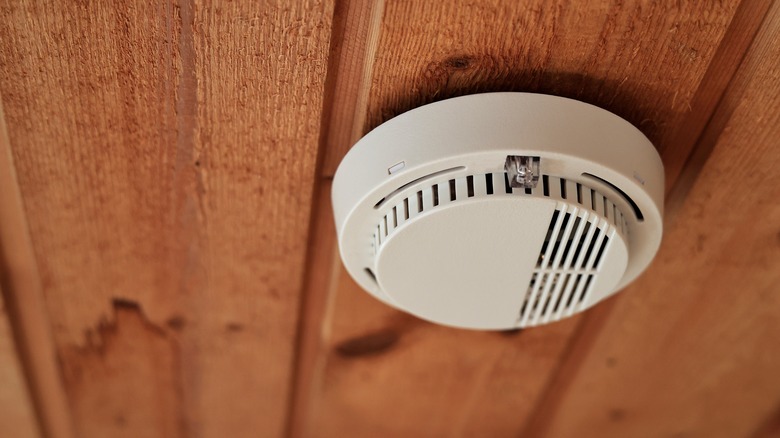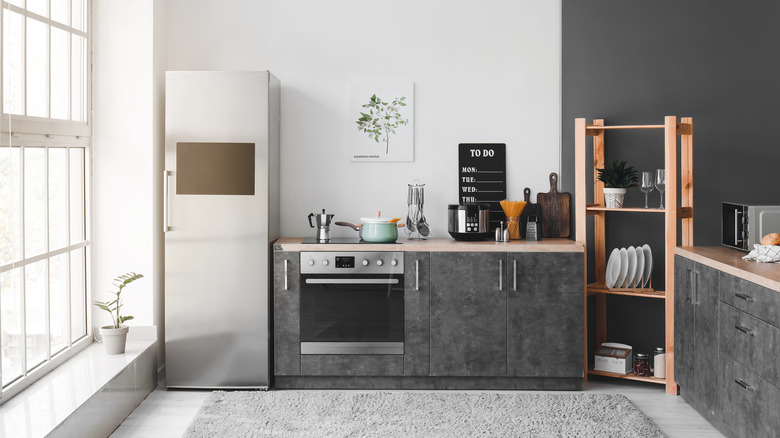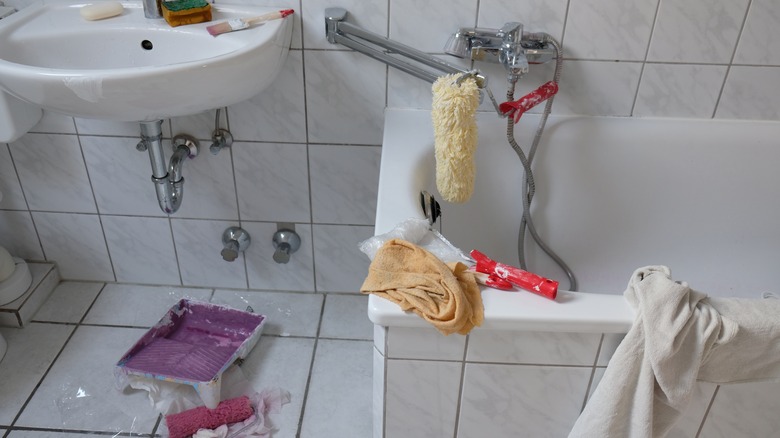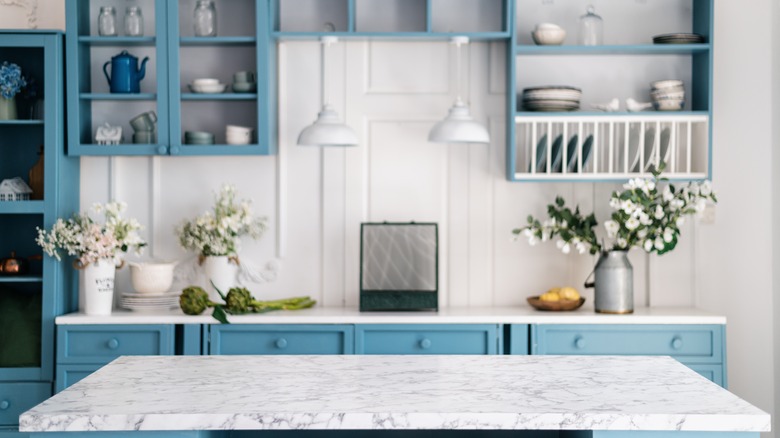Think Twice Before Painting These 10 Items Around The House
Dipping a brush in your favorite can of paint or shaking a bottle of spray paint to give your household items a small makeover can breathe new life into them without burning a hole in your pocket. While unconventional paint hacks and expert tutorial videos have made such projects simple, accessible, and DIY-friendly, a fresh coat of paint isn't the answer to all of life's problems (like ice cream and chocolate!). Thus, you should think twice before painting a few items around the house, such as cutlery. Even though paint can spruce up your silverware and give it a new and funky look, it's best to steer clear of staining it since paint isn't safe for consumption and should be avoided at all costs.
Similarly, you can stain antique wood furniture to restore its former glory or give it a contemporary look, but paint will irrevocably alter its appearance. This might not be a big deal if the fixture has seen better days, and you just want to use it around your home for the foreseeable future. However, it might negatively affect the furnishing's resale value if the original material (think mahogany, cherry, and satinwood) is valuable and in good shape. That being said, here are some other household items you'd be better off not painting.
Tiles: The cons outnumber the pros
Painting over your outdated tiles might seem like an easy, time-effective, and budget-friendly fix, but that's all it is: a temporary fix. The paint will begin peeling and chipping after some time, especially if the tiles witness heavy traffic or moisture from showers, necessitating re-applications. Not to mention the intensive prep — washing the tiles, removing dirt, grease, and mildew, and drying them, followed by sanding and priming. You'll have to get through all that before you can apply a fresh coat. Moreover, you'll have to choose a paint type, like epoxy, that'll adhere to most tiles.
So, instead of painting tiles to transform your bathroom, invest in new ones and replace the existing ones. If that's not a feasible option, purchase peel-and-stick vinyl flooring. It's not only more affordable than actual tiles and DIY-friendly but can also last between five and 25 years if maintained adequately. However, if you've got your heart set on paint, contact a professional and get them to paint the tiles. You won't just benefit from the superior work quality; the ensuing guarantee or warranty will ensure you're covered in case the painted areas need to be redone. You can also extend the painted tile's lifespan by covering suitable areas like the doorway with a rug.
Cookware: Can cause health concerns
Painting your old cookware can be a tempting offer. After all, who wouldn't want to touch up the less-than-stellar pieces and make them look new again? However, refrain from giving in to temptation, and don't use paint on any item you use to prepare food — like pots, pans, and microwaveable dishes. Since the chemicals in paint can leak into your food, it can cause health issues. For instance, a mild dosage of water-based paints — such as tempera, latex, and poster — could irritate your skin and mouth. But higher quantities can lead to more serious problems, and the solvents in oil-based paints can lead to poisoning.
Thus, it's best to leave your cookware alone and keep them away from paint. Replace the old ones that have begun chipping and invest in sturdy pieces, like those made of stainless steel, to ensure they last you a few years. Besides, don't throw out your old dishware. Use enamel spray paint to give them a fresh look. After the coat dries, strategically place them around the house to repurpose them as showpieces or as holding spots for your knick-knacks like car keys and loose change. Note: You should also replace Teflon-coated dishware when the upper coating begins peeling off, as it could be harmful if consumed.
Historical woodwork: Considered a crime by purists
If your house features original woodwork, press pause and step back from your latest DIY paint project. Although painting them will give your interiors a lift, this modernization will also cost you your home's historical significance, according to Hannah Maple, the House of Maple designer and a purist. "If you happen to live in a home with original wood-stained millwork, it may be tempting to lighten it up with paint, but don't! Instead, lean into the character it provides and embrace its unique beauty," she told Southern Living.
Ultimately, the decision to paint or stain the original woodwork boils down to your preference, the quality of artistry, and the wood's state. To elaborate, if you live in a home where the wood is in a good condition and the details on it are breathtaking, salvage it with a high-quality stain (possibly in the same color as the original) instead of paint. This will give your interiors character and draw eyeballs. But if the woodwork is shoddy and rundown, it might benefit from a fresh coat. However, take a few important steps before painting your woodwork, like sanding the surface, filling holes, and using a primer. Also, pick an oil-based paint with a semi-gloss finish to conceal the flaws in your woodwork and make it pop.
Wood floors: A difficult project that requires extensive prep
Painting your hardwood floors might initially seem like a straightforward and fun project, but things can go awry very quickly if you don't know what you're doing. You'll need to consider the type of wood, its current stain, the underflooring, and any imperfections. The prep work involves sanding the surface, filling cracks and gaps, fixing scratches, staining, and sealing the wood. Moreover, you have to be cognizant of the type of paint finish you use on your wood flooring. Think matte, semi-gloss, and eggshell finishes. You'll also have to get paint that's manufactured specifically for floors.
The buck doesn't end here. Even if you follow the prep process down to a T and use high-quality paint, chances are it'll begin peeling after only a few years in high-traffic areas. Though this problem is not difficult to take care of, it's not a one-and-done project either. Further, if you want to go back to the original shade a few years down the line, that won't be a realistic option. So, getting a professional to refinish your wooden flooring is better than undertaking this DIY job and possibly damaging it in the process.
Door knobs and hinges: Rarely worth the effort
Hardware like doorknobs and hinges are the unsung heroes that improve your door's functionality and anchor the space they're used in. However, if you're hoping to paint the old ones to lend them a fresh look, think again. After drying, the paint will become hard and hamper the hardware's ability to function well. For instance, it'll be difficult for a painted hinge to rotate adequately. The same logic applies to locks. Further, the paint will come off from the hardware (like knobs) with constant use, detracting from their look and negating all your hard work. Fingerprints will also be more visible after the knobs are painted than on metal surfaces.
So, the best course of action is to replace the hardware and install a new set that goes with your overall design scheme instead. But if your current hardware features intricate designs that you'd be hard-pressed to part with, contact a professional to refinish them for you. In case you want to touch up the hardware yourself, remove them from the doors, clean them, and spray paint the doorknobs and hinges. Let them dry for around 24 hours before putting them back in the door.
Smoke detectors: Can be a safety hazard
Smoke detectors are essential for detecting smoke and triggering a warning to the occupants. Admittedly, you'll have to quiet your chirpy smoke alarm in cases of false positives, but these devices shouldn't be tampered with otherwise, as that could compromise its functionality and your safety. So, if you're thinking of painting them to make them look beautiful, don't do it. The layer of paint will impede airflow and restrict the amount of smoke entering the device. This will make detecting a fire difficult for the detector, putting you at risk. The same applies to carbon monoxide detectors.
This is the reason smoke detectors usually come with a "DO NOT PAINT" warning label; heed that and don't attempt to paint them. In case they get painted over when you're applying a fresh coat on your ceiling, replace them at once. If you don't like the sterile ones, you can even get a colored piece that'll be easier to match with the ceiling and won't stand out much.
Electrical appliances: Might affect your device's warranty and performance
In theory, painting your electrical appliances — like the oven, washing machine, and fridge — is a cost-effective way of customizing the devices and updating their look. In reality, however, it's the complete opposite. A paint job can void the warranty of the appliance in question and even negatively impact its performance. For instance, if the paint causes a machine to rust or shut down, the warranty won't cover it, and you'll have to bear the costs. Your personal devices, like laptops and smartphones, fall under the same category. The paint might block the breathable openings and cause the appliance to malfunction.
Hence, it's best to keep paint away from your electrical appliances. But if you'd rather give them a personal touch, hire a certified professional to get the job done. If the device's warranty has expired and you're fine with paying for the repairs out of your pocket should anything go wrong, you can even paint the appliances yourself to upgrade them. Alternatively, if the appliances are on their last legs, it'd be best to invest in new ones. You can even spring for colorful machines featuring eye-catching designs. As for your personal devices, buy bespoke covers to personalize them.
Bathtubs: Can become a hotbed for mold
If your bathtub looks worn down and has numerous small scratches across its surface, a fresh coat of paint can work wonders for it. But that's where the fun ends and the work begins. Painting a bathtub requires extensive prepping, including sanding its surface, using epoxy putty to cover unsightly gaps, and applying primer and two thin coats of paint before buffing the surface. Though the list of activities seems doable and a fun DIY project, it's anything but. Further, the constant heat and moisture will make it hard for the paint to last. To make matters worse, if the paint cracks and isn't treated adequately, it could become a hotbed for mold, putting your bathtub and bathroom out of commission.
Given the prep required and the potential for mold down the road if the paint job isn't performed properly, refinishing a bathtub might be best left to experts or experienced DIY-ers who understand the requirements well and can adhere to them. The materials they use and their superior technique will help your refinished tub last longer. The best part, though? The accompanying warranty will make it easier for you if the tub needs to be touched up after some time. However, if your budget allows, it'd be better to spring for a new bathtub and sell the old one.
Countertops: Requires a professional touch
Bathroom and kitchen countertops are subject to a lot of wear and tear on a regular basis and might look worn after a few years. Even though painting them will give them a new lease on life, it's important to consider what you'll need to undertake this project. You'll require expertise, an endless supply of patience, and time to spare, since the process is far more complicated than choosing your favorite shade and getting in the zone. You'll have to clean and prep the surface, apply primer, and paint and seal it, while ensuring heat and moisture don't come in contact with the countertop being dressed.
Moreover, not every countertop material can be painted. While you can paint laminate countertops, stone materials like marble and granite are poor candidates. Not to mention, you won't be able to use your kitchen and bathroom properly until the paint and sealant adhere to the surface (which could take a few weeks), or your hard work will be for naught. So, it's recommended that you hire pros to take care of this paint job and let them finish it in a timely fashion. However, outsourcing the project could be tough on your budget, so it might ultimately be better to get new countertops installed.
Upholstered furniture: Knowledge is key
Given the significant rise in the price of upholstered furniture, painting your old chairs could seem like an excellent idea. However, instead of rushing into the project and spraying your furniture with your favorite color, you need to consider a few factors — like the type of paint — if you don't want to turn your worn but drab chair into a stiff and uncomfortable seat. For instance, you don't want to use latex or acrylic paints on the fabric if you'd rather not sit on a rigid surface.
Begin by cleaning and vacuuming the fabric to get rid of the accumulated dirt, dust, and grease. Next, purchase a few cans of upholstery-specific paint or spray bottles in a shade of your liking (just ensure it's darker than the current hue). Since upholstered fabrics are incredibly absorbent, you'll need a lot of paint to change the color. After you've got the paint, spot-test an inconspicuous area before you begin painting the chair in earnest. If the spot test yields positive results, apply multiple coats (until you see the color you want), allowing the fabric time to dry after each coat.
